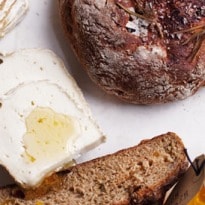Homemade loaves are always a joy, but adding a spoonful of honey to the mix will surprise and delight you.
The days may start with frost on the hedges, but by mid-afternoon there is often warm sun, too, tempting me back into the garden to rake and dig, prune and perhaps sow. I come inside for tea, scratched and aching, to be restored by tea and toast. My reward is pouring honey over the surface of the hot, crisp bread.
A pot of honey is often my souvenir from a trip to a farm shop or a visit to the countryside, but I have been enjoying a batch of urban honeys of late from hives in unexpected locations - such as the back gardens of shops and the roofs of tower blocks - a world away from the buttercup fields and heather-clad hills of country honey. This week alone I have enjoyed a very floral version from a hive of Polish bees in Kensington; a more resinous one from hives in Hyde Park; a light and lemony pot from a hive of Devon bees now living six floors up in Chelsea, and honey from Spitalfields and also from Notting Hill. I like the idea of hives in the hood as much as in a clover-dappled field.
In this kitchen, honey is not just found in a glass pot on the table, and is as likely to end up in a recipe as it is on a piece of bread. Not only is it a golden prize on top of your crumpets or spooned on to your porridge (incidentally the best way yet to get the subtle notes of a fine pot of gold to show its hand), honey is a useful addition when making bread dough, too, just as it is to the tighter dough of a batch of crispbread. Its presence gives not only a mild sweetness but depth, too, and a pleasing, mellow quality to the finished bread. I also feel it helps the keeping quality, but that may be my imagination.
For cooking I use a lightly flavoured honey, avoiding the chestnut and strongly flavoured types that can dominate. (I have a French honey in the cupboard that tastes not dissimilar to cough mixture.) When you cook with a delicate honey, most of its more interesting qualities are lost, so it is best used on toast, English muffins or crumpets. A more interesting idea is to trickle a little lightly flavoured honey over a slice of goat's or sheep's cheese. The more strongly flavoured cheeses work best, but a spoonful of floral "bee jam" on a soft, fresh goat's cheese has a certain elusive charm. Reward indeed.
Rosemary and honey bread for cheese
Moist, sweet and salty, these spongy loaves will keep for two or three days if wrapped in kitchen film. With its sweet fruits and herbal notes, this is a perfect bread for cheese. Makes two small loaves.
strong wholemeal flour 250g
strong white plain flour 250g
salt 1 tsp
warm water 350ml
honey 1 tbsp
fresh yeast 40g
rosemary 2 tbsp
dried cherries 50g
dried apricots 50g
golden sultanas 50g
rosemary stalks a few, to decorate
sea salt flakes
Put the two different flours in a large mixing bowl, add the salt and mix thoroughly. Pour the warm water into a small bowl then stir in the honey and yeast. When they have dissolved add the chopped rosemary.
Tip the yeast and honey mixture into the flours and stir in the cherries, apricots and sultanas. If you are using a food mixer armed with a dough hook (a flat paddle will work just as well) then mix for four or five minutes. You should have a dough that is really quite sticky. Cover it with a cloth and leave in a warm, but far from hot, place for about an hour until risen and lightly spongy.
Flour a large chopping board or work surface, tip the dough on to it and slice in half. Roll each piece of dough into a ball and place on a lightly floured baking sheet. Scatter the surface of each loaf with a few rosemary stalks and a few pinches of sea salt flakes. Cover with a cloth and leave for about 20 minutes, until the dough has flattened and spread slightly. Set the oven at 220C/gas mark 8.
Bake for 25 minutes, until dark brown, remove from the oven and transfer to a cooling rack. When cool, slice and serve with goat's cheese and mild honey.
Rye poppy-seed crispbread
Home-made crispbread is something I bake often at home, using poppy, sunflower or pumpkin seeds on the surface, and occasionally using oats, oatmeal or spelt in the dough. Makes 12.
rye flour 100g
plain spelt flour 100g
oat bran 50g
easy-bake dried yeast 7g (a heaped tsp)
sea salt ½ tsp
honey 3 tsp
warm water 150ml
poppy seeds
Put the flours and bran into the bowl of a food mixer, tip in the yeast and salt, then turn once or twice to stir evenly through the flour. Dissolve the honey in the warm water, then pour most of it into the flour, the paddle turning slowly. The dough needs to be soft but not sticky, so you may not need all the liquid.
Leave the mixer going for a good three or four minutes, until the dough comes cleanly away from the sides of the bowl.
Turn off the machine, remove the bowl, and leave the dough in a warm place, covered with a cloth, for about half an hour. Set the oven at 200C/gas mark 6.
Lightly flour the worksurface - I like to use a large wooden board - tip the dough on to it, then tear off pieces the size of a golf ball. Roll each piece out to roughly the size of a side plate and thickness of a 10p piece, laying each one on a baking sheet. With two baking sheets on the go I can bake eight at a time. Scatter lightly with poppy seeds, pressing them down into the surface with your hand.
Bake for 12 minutes, then transfer the breads to a cooling rack and leave for several minutes to crisp even further. They will keep in good condition in a tin for a few days.
Email Nigel at nigel.slater@observer.co.uk
Photograph: Jonathan Lovekin for the Observer








